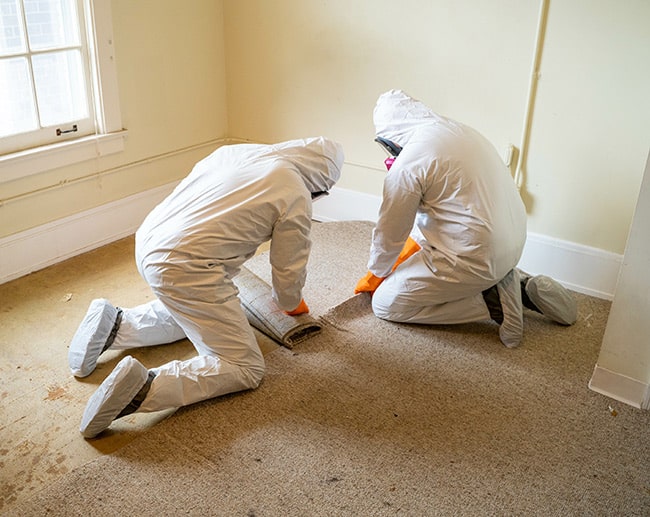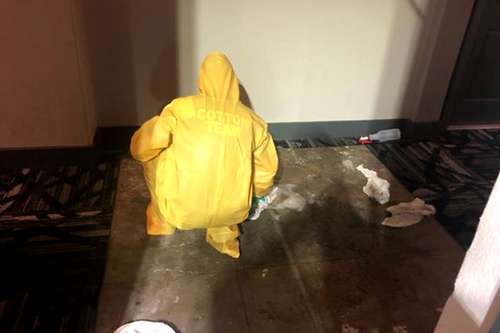Clandestine Lab Cleanup: Comprehensive Purification for Hazardous Sites
Clandestine Lab Cleanup: Comprehensive Purification for Hazardous Sites
Blog Article
Expert Biohazard Cleansing and Purification for Blood, Bodily Fluids, and Hazardous Materials
In the world of biohazard cleansing and decontamination for blood, bodily fluids, and harmful materials, accuracy and knowledge are paramount. The prospective wellness risks related to direct exposure to biohazards emphasize the crucial requirement for meticulous handling and comprehensive cleaning. Specialized training outfits experts with the expertise and abilities essential to resolve these dangerous circumstances properly. However, it is not merely about cleansing up; the value of utilizing correct decontamination strategies can not be overemphasized. As we navigate the elaborate landscape of biohazard cleaning, understanding the nuances of guidelines, compliance, and the customized equipment at play becomes critical in making certain a thorough and secure purification process.
Health Risks of Biohazard Exposure
Exposure to biohazards poses substantial health and wellness risks that can result in severe consequences for people and areas alike. Biohazards include a variety of biological materials, consisting of blood, bodily liquids, mold, microorganisms, viruses, and various other potentially transmittable products. When individuals enter call with these biohazards, whether via mishaps, incorrect handling, or environmental exposure, they encounter the threat of having major diseases or conditions.
Among the main health and wellness threats related to biohazard direct exposure is the transmission of transmittable conditions. Bloodborne virus such as HIV, hepatitis B and C, and various microorganisms can be present in biohazardous materials, positioning a straight hazard to human wellness. Breathing in air-borne biohazards like mold and mildew spores or entering call with polluted surfaces can additionally bring about respiratory system issues, allergic reactions, and other unfavorable health and wellness impacts.
In addition, biohazard exposure can have long-lasting health and wellness implications, with some illness manifesting years after the initial contact (Blood Cleanup). Consequently, it is important to focus on appropriate biohazard cleaning and purification to alleviate these wellness threats and ensure the security of areas and people

Specialized Training for Biohazard Cleaning
When it comes to managing biohazard cleaning successfully and safely, specialized training plays a fundamental duty in making certain appropriate purification treatments are followed. Biohazard cleanup needs particular expertise and skills to effectively reduce risks related to bloodborne microorganisms, physical fluids, and hazardous materials. Professionals learnt biohazard cleanup undertake strenuous instruction on just how to safely handle, get rid of, and take care of biohazardous products to avoid contamination and direct exposure.
Specialized training for biohazard clean-up covers a range of essential topics, consisting of correct personal safety equipment (PPE) use, bloodborne pathogen awareness, decontamination methods, and contaminated materials disposal methods. People trained in biohazard cleaning are equipped with the needed proficiency to assess contamination degrees, recognize prospective hazards, and carry out appropriate cleaning treatments in compliance with regulatory requirements.
Continuous training and education and learning are vital in the area of biohazard clean-up to stay upgraded on the current decontamination innovations, safety and security procedures, and guidelines. By purchasing specialized training, biohazard clean-up professionals can efficiently respond to emergency cleaning scenarios and protect both public wellness and the environment.
Importance of Correct Decontamination Techniques
Making use of correct decontamination strategies is important in biohazard cleaning to properly reduce and remove harmful materials health and wellness threats. Effective purification not only ensures the elimination of noticeable traces of blood, bodily fluids, and various other biohazards yet also targets invisible pathogens that may position major health dangers otherwise correctly eradicated. By adhering to strict decontamination methods, educated specialists can dramatically minimize the danger of exposure to dangerous microorganisms, infections, and microorganisms that can cause conditions or infections.
Appropriate decontamination techniques entail using customized equipment and disinfectants that are especially created to reduce the effects of biohazards successfully. Comprehensive cleaning and sanitation of polluted areas are necessary to avoid the spread of pathogens and guarantee a secure atmosphere for occupants. Additionally, the proper disposal of biohazardous waste following decontamination procedures is crucial in preventing contamination of various other surface areas or individuals.

Devices and Devices for Safe Cleanup
The proper devices and tools play a critical role in guaranteeing the safe and effective cleaning of biohazardous products. When managing blood, bodily liquids, or harmful materials, biohazard cleaning professionals rely on specialized gear to minimize exposure threats and thoroughly sanitize the affected location. Individual protective tools (PPE) such as gloves, coveralls, goggles, and masks are vital to shield against direct call with possibly contagious products. In addition, biohazard cleansing sets including anti-bacterials, absorbing materials, and biohazard bags are used to securely get rid of and have of polluted products. Blood Cleanup.
Advanced cleaning devices like hospital-grade disinfectants, HEPA-filtered vacuums, and misting machines are employed to sterilize surfaces and eliminate biohazards successfully. Specialized devices such as sharps containers and biohazard waste disposal bins are made use of to securely handle sharp things and biohazardous waste products. By making use of the appropriate equipment and tools, biohazard cleansing specialists can guarantee a detailed cleaning procedure that prioritizes safety and security and lessens health risks for both employees and residents of the affected area.
Rules and Conformity in Biohazard Cleansing
Proper adherence to regulations and compliance criteria is paramount in biohazard cleansing to make sure the security of both personnel and the setting. dig this Government companies such as OSHA (Occupational Safety and Health And Wellness Management) and the EPA (Epa) have actually developed specific guidelines for biohazard cleaning procedures to reduce health and wellness dangers and ecological contamination. These laws cover a variety of aspects consisting of the handling, transport, and disposal of biohazardous products, as well as the required training and safety tools required for workers entailed in the clean-up procedure.
Biohazard cleaning business need to stay current with these policies to assure that their operations meet the needed safety requirements. Failing to adhere to these laws can cause severe effects, including fines, lawsuit, and jeopardizing the health of people and the setting. By adhering to rigorous policies and compliance measures, biohazard cleansing companies can effectively reduce threats and make sure a extensive and risk-free clean-up process for all events included.
Final Thought
To conclude, biohazard cleansing and purification require specific training, correct methods, and adherence to regulations. Direct exposure to blood, bodily liquids, continue reading this and unsafe products presents substantial health and wellness threats, making it vital to utilize the best devices and tools for safe cleanup. By following rigorous protocols and guidelines, specialists can properly alleviate the threats associated with biohazard direct exposure and make certain the safety and security of both themselves and others.
As we browse the elaborate landscape of biohazard cleanup, comprehending the subtleties of laws, compliance, and the customized devices at play comes to be crucial in guaranteeing a complete and safe purification procedure. (Blood Cleanup)
When it comes to handling biohazard cleaning efficiently and securely, specialized training plays an essential function in making certain correct decontamination treatments are followed.Using appropriate purification techniques is important in biohazard cleaning to properly lessen and get rid of unsafe materials health and wellness threats. In addition, biohazard cleaning packages containing anti-bacterials, absorbent materials, and biohazard bags are used to safely consist of and get original site rid of of infected things.
Federal government companies such as OSHA (Occupational Safety And Security and Health Administration) and the EPA (Environmental Protection Agency) have established particular standards for biohazard clean-up treatments to decrease health and wellness threats and ecological contamination.
Report this page